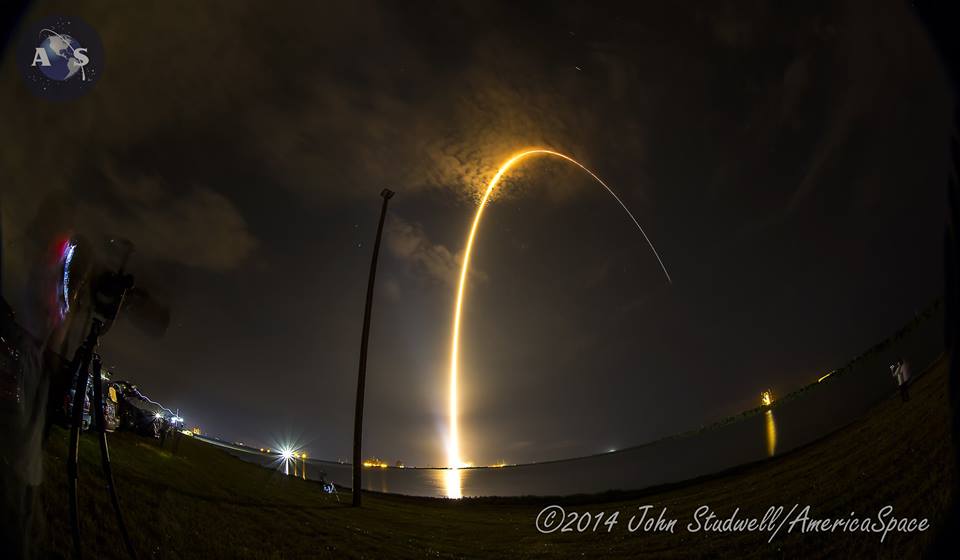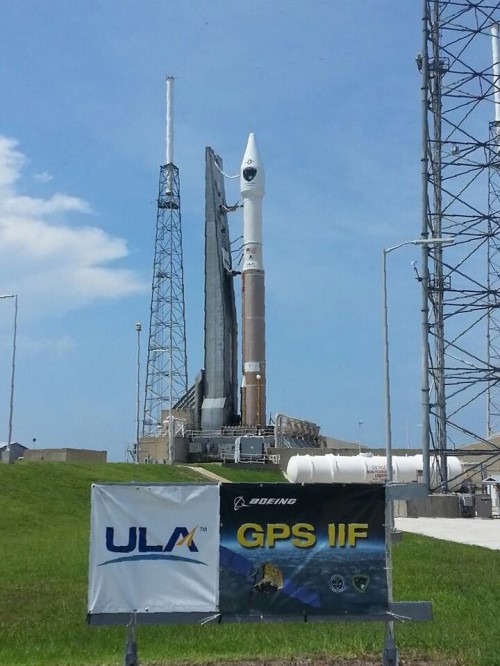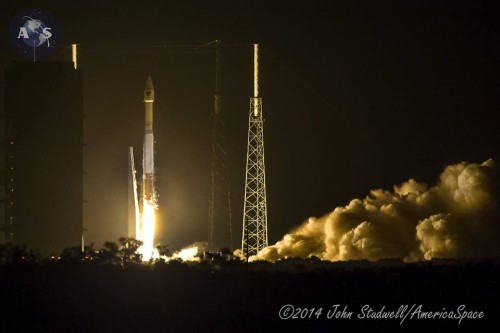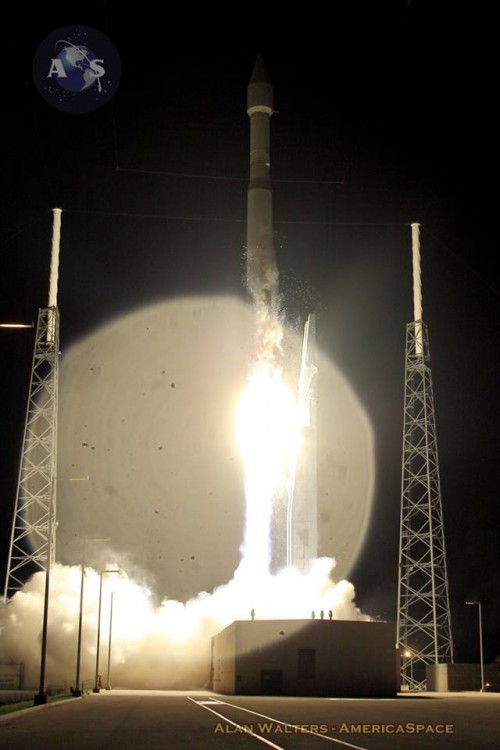
In stark contrast to the primarily weather-related delays which plagued its predecessor, the Air Force Space Command (AFSPC)-4 mission, United Launch Alliance (ULA) scored an impressive, on-time liftoff of its ninth flight of 2014 at 11:23:01 p.m. EDT Friday, 1 August. Under clear skies, and enjoying 100 percent acceptable weather, the Centennial, Colo.-based launch services company sent its venerable Atlas V roaring into orbit from Space Launch Complex (SLC)-41 at Cape Canaveral Air Force Station, Fla. The successful mission delivered the seventh Global Positioning System (GPS) Block IIF satellite into a medium orbit, about 11,047 nautical miles (20,460 km) above Earth.
Coming just four days after the AFSPC-4 launch, this mission established a new record for ULA, as well as marking the third occasion in 2014 that the company has delivered pairs of vehicles within a week of one another. “Congratulations to the U.S. Air Force and all of our mission partners on the successful launch of the Atlas V, carrying the GPS IIF-7 satellite,” said Jim Sponnick, ULA vice president of Atlas and Delta Programs, quoted in a news release. “ULA launch vehicles have delivered all of the current generation of GPS satellites, which are providing ever-improving capabilities for users around the world.” Mr. Sponnick added that three pairs of missions, within the span of a single week, within a single calendar year, meant that “the ULA team’s focus on mission success, one launch at a time, allows us to be ready when our customers are ready to launch.”
As described in AmericaSpace’s GPS IIF-7 preview article, the 196-foot-tall (60-meter) Atlas V vehicle—flying in its “401” configuration, with a 13-foot-diameter (4-meter) payload fairing, no strap-on rocket boosters, and a single-engine Centaur upper stage—undertook its 35-minute rollout from the Vertical Integration Facility (VIF) to SLC-41 on Thursday morning. Upon arrival at the pad, ULA technicians set to work transitioning environmental monitoring and other systems from the Mobile Launch Platform (MLP) support convoy to the launch complex’s own ground support hardware. Weather predictions for a successful Friday night liftoff had by this point improved from 70 percent to 80 percent favorable, with key concerns centering on anvil clouds, thick clouds, and cumulus clouds.

Shortly after 5 p.m. EDT, the countdown got underway at T-6 hours and 20 minutes and the vehicle underwent extensive testing of its ground commanding and communications systems, and the fuel lines were purged with inert gaseous nitrogen, preparatory to the loading of liquid oxygen and a highly refined form of rocket-grade kerosene (known as “RP-1”) aboard the Atlas V. At T-2 hours, the Launch Director issued a “Go” to commence fueling—a lengthy process which began with the chilling down and pressurization of the propellant lines. By 10:34 p.m., a little less than an hour before the 11:23 p.m. opening of Friday night’s 18-minute “window,” the liquid oxygen tank was reported as full and transitioned into “topping” mode, whereby it would be continuously replenished to replace boiled-off cryogenics until close to launch time. Under the glare of powerful xenon floodlights at SLC-41, the distinguishing copper-colored hue of the Atlas V main body turned almost white as frost formed on the exterior surface of the propellant tanks.
Despite a handful of lightning warnings earlier in the day, weather conditions at the launch site were classified at 11:08 p.m. as 100 percent favorable and “Green” (“Go for Launch”) was issued. By now, the countdown clock had halted in its final pre-planned hold at T-4 minutes. After a final poll of all stations, the Launch Director authorized a “Go for Launch” at 11:17 p.m., and the clock was duly released from its hold at T-4 at 11:19 p.m. This began the so-called “Terminal Count,” under whose auspices the rocket’s autosequencer assumed primary command of all vehicle critical functions. Liquid oxygen replenishment ended, the fuel and oxidizer valves were closed for flight, and propellant tank pressures were verified to be at Flight Pressure. At T-25 seconds, the final status check was met with a crisp triplet of “Go” calls to confirm the readiness of the Atlas, its Centaur upper stage, and the GPS IIF-7 payload for their journey into space.
At T-5 seconds, water began to flood across the SLC-41 pad surface and into the flame trench, in order to minimize reflected energy and suppress acoustic waves at the instant of liftoff. The ignition sequence of the Atlas V’s single, Russian-built RD-180 engine got underway at T-2.7 seconds, punching out 860,000 pounds (390,000 kg) of thrust. “A plume of exhaust, steam, flames and dirt is thrown up from the flame trench as the thrust builds,” reported AmericaSpace’s Launch Tracker. Liftoff took place on time at 11:23:01 p.m., with the Atlas—whose thrust-to-weight ratio is only 1:16—initially lumbering off the pad and into the darkened Florida sky at T+1.1 seconds. The booster climbed vertically for the first 16 seconds of the mission, after which the Centaur avionics commanded a pitch, roll, and yaw program maneuver to actively guide the stack onto a north-easterly trajectory, with a flight azimuth of 45.8 degrees, to deliver GPS IIF-7 into orbit.
“Thirty seconds after launch, the Propellant Utilization system started actively modifying the liquid oxygen/RP-1 mixture ratio supplied to the RD-180 main engine to optimize propellant consumption,” it was reported by Spaceflight101. “Once the pitch maneuver was complete, the launch vehicle switched to Zero Angle of Attack flight mode, flying a pre-programmed attitude profile that was calculated based on upper-level winds before liftoff.” About four minutes into the flight, the RD-180 was shut down and the 41-foot-long (12.4-meter) Centaur and attached GPS IIF-7 payload were detached.

The next stage of the flight incorporated a pair of Centaur “burns” to deliver the satellite into a medium-altitude orbit of 11,047 nautical miles (20,460 km), inclined 55 degrees to the equator. The initial burn of the Centaur’s 22,300-pound-thrust (10,100-kg) RL-10A liquid oxygen/hydrogen engine got underway at 11:27:20 p.m. and lasted for 13 minutes. During this period, the two-piece (or “bisector”) payload fairing was jettisoned, exposing the 3,600-pound (1,630-kg) GPS IIF-7 satellite to the space environment for the first time, and a second Centaur burn began about three hours after launch. It lasted just 1.5 minutes, and the Centaur was employed to spin-up its precious payload to about five revolutions per minute and release it into free flight at T+3 hours and 23 minutes.
The GPS IIF-7 mission is the third occasion in 2014—following February’s launch of GPS IIF-5 and May’s flight of GPS IIF-6—that a member of the “interim” Block II Global Positioning System constellation of satellites has been delivered into orbit. In total, it will be the 11th operational GPS to be launched by a ULA vehicle, since the company’s formation in December 2006, and only the second in history to be lofted atop an Atlas V. It is anticipated that the 12-satellite GPS Block IIF network will employ a mixture of both Atlas V and Delta IV launches, with the latter employed to place both GPS IIF-5 and IIF-6 into orbit, and an Atlas V slated to deliver GPS IIF-8 in October. Friday night’s mission will help to keep the Navstar network of worldwide positioning, velocity, and timing assets fully operational until the next-generation GPS Block IIIA comes online in 2016.
Throughout the ascent phase, telemetry data will be gathered by the Eastern Range, together with various worldwide installations under the U.S. Air Force Space Command Network, including New Boston Air Force Station, N.H., the Royal Air Force’s Oakhanger installation in Hampshire, England, Diego Garcia in the Indian Ocean, and Guam in the western Pacific Ocean. Additionally, NASA’s Tracking and Data Relay Satellite System (TDRSS) will participate in the gathering of telemetry.
From its semi-synchronous, medium-altitude Earth orbit, GPS IIF-6 will circle Earth once every 12 hours. It represents the seventh satellite in a 12-strong network of GPS Block IIF spacecraft, the first of which was launched in May 2010. A second satellite followed in July 2011, then a third in October 2012 and a fourth in May 2013. With Friday’s launch, three more have followed in 2014 and another (GPS IIF-8) is scheduled for October.

The GPS IIF boasts improved positioning, velocity, and timing accuracy, a reprogrammable processor, an interference-free civilian signal for commercial aviation search and rescue, and a new Military code (or “M-code”) to offer better resistance to electronic jamming. “As each IIF satellite becomes operational, we continue the seamless transformation of the GPS constellation into an even more accurate, reliable, and durable navigation resource for the U.S. military and the global civilian user community,” said Craig Cooning, vice-president and general manager of Boeing Space & Intelligence Systems. “Our efficient pulse-line manufacturing process, adapted from Boeing’s commercial airplane production lines, also ensures that we deliver each spacecraft on time and on cost.”
In the meantime, the Air Force expects the next-generation GPS IIIA network to enter service no earlier than April 2016, about two years later than originally intended. It awarded a $1.4 billion contract to Lockheed Martin in May 2008 to develop this new network, which may eventually comprise as many as 32 satellites, although the Air Force has only formally contracted for four of these. With 500 times the transmitter power of current systems, the IIIA satellites will benefit from improved navigational warfare capabilities, enabling them to shut off GPS services to limited geographical locations, whilst maintaining service to U.S. and allied forces. The GPS satellite system is operated and controlled by the 50th Space Wing, located at Schriever Air Force Base, Colo.
– Want to keep up-to-date with all things space? Be sure to “Like” AmericaSpace on Facebook and follow us on Twitter: @AmericaSpace
Missions » GPS » GPS IIF-7 »


